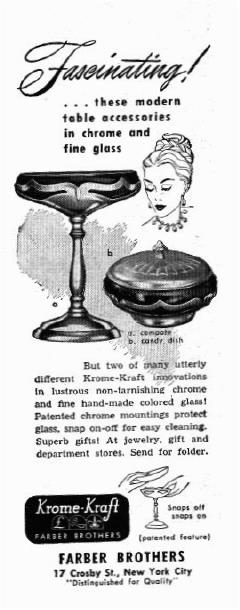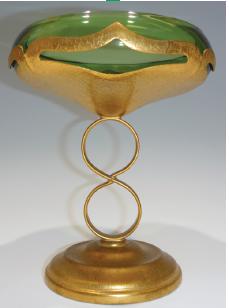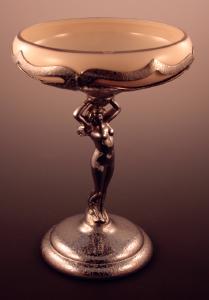The Modularity of Farber Brothers-Krome Kraft
and their Cambridge Compote Insert
by Alex Wolk
Issue No. 440 - August 2010
Collecting Farber Brothers-Krome Kraft has been
a passion of mine for over a decade. Because the
majority of the glass used to manufacture Farber
Brothers items was made by the Cambridge
Glass Company, I have become quite interested in
 Cambridge Glass and have also become an avid
collector of Cambridge enjoying both collections
side-by-side. Many of the molds used to make
Farber Brothers glass inserts were also used by
Cambridge for their own creations. Farber Brothers
produced such an enormous variety of pieces, but
for purposes of this article I will concentrate on the
five and a half inch blown bowl portion used by
Cambridge to make compotes.
Cambridge Glass and have also become an avid
collector of Cambridge enjoying both collections
side-by-side. Many of the molds used to make
Farber Brothers glass inserts were also used by
Cambridge for their own creations. Farber Brothers
produced such an enormous variety of pieces, but
for purposes of this article I will concentrate on the
five and a half inch blown bowl portion used by
Cambridge to make compotes.
In speaking about compotes, Cambridge produced their blown bowls and attached them to a wonderful variety of different glass stems and feet, but once together these would obviously remain that way. Farber Brothers, on the other hand, was able to take that very same Cambridge Glass compote bowl and snap them into a great many different metal stems, bases and holders, thereby creating a new type of product that appealed to many for different reasons. Some liked it because the bowl portion of the glassware could be snapped out for easy cleaning, one of Farber Brothers-Krome Kraft's greatest marketing pitches, and others liked them because of its modularity.
Farber Brothers also advertised the availability of replacement inserts, so if a glass insert became chipped or broken, another one could be purchased to replace it, thus making the item more economical. The cost of a glass insert was much less than buying a whole new piece. A cobalt compote could be made into a carmen one, or a low stemmed compote could be transformed into a high one. In fact, Farber Brothers took that one piece of glass and designed dozens of different items.
When hunting for Cambridge Glass, a collector must always check the entire piece to make sure that it is chip, crack and defect free. With Farber Brothers, a different strategy comes to play. One may find a Farber Brothers compote with its glass bowl in perfect condition, but the metal stem/base may either be split, broken or so badly pitted that it would usually be passed up. But here is where the modularity of Farber Brothers makes collecting it so fun. Many times during antiquing expeditions I have come across such pieces and purchased them for what we in the Farber Brothers collecting field have come to call 'parts'. It would not be unusual in the same day to find another compote, perhaps one in a different color, where the stem or base holder is perfect, however the glass bowl is either chipped or hopelessly cracked. In both cases I am able to get these pieces rather cheaply, and when I get home, the fun really begins. I take what good 'parts' I have found, and assemble them into perfect pieces.
Some restraint must however be exercised, as many of the items marketed by Farber Brothers were only sold in certain color and metal finish combinations. For example, bon-bons and butter dishes that were sold in the late 1940s and 1950s would not have been offered in carmen. In fact, in the 1950s and into the early 60s, the only glass colors offered by Farber Brothers for sale were amber, amethyst, green, crystal and also milk. We know this from a handful of surviving catalogues. I have made it a point in previous seminars I have given on the topic and will continue to do so in future discussions, to educate those interested as to how Farber Brothers items were actually sold with respect to the color of the glass used for specific pieces and what metal finishes these would have been sold in.
Farber Brothers creations employing the five and a half inch compote bowl were sold in many different stems, bases and holders with a nice variety of metal lids/covers for their cheese and butter dishes as well as other articles. The metal parts were sold in chrome, brass, silverplate, Sterling Silver (as marketed by the Sheffield Silver Company; owned by Farber Brothers), a wonderful mosaic gold plated finish and also in a mosaic chrome plated finish. Farber Brothers also used pewter, copper and nickel plate in the manufacture of their wares, but these metal finishes were predominantly used for all metal hollow-ware items.
The glass used in compotes
was offered most commonly in amber, green and
amethyst, but was also sold in carmen, cobalt, milk,
ebony, crystal and mocha. One known example of
a plain crystal insert exists, but other crystal inserts
were almost always etched Chantilly, and sometimes
in Diane. It is possible that the crystal compote insert
was also sold with an Elaine etching, but I have
 never seen one in all my years of collecting Krome
Kraft. If someone out there has one, I would love
to have a picture of it. Crystal compote bowls can
also be found with two beautiful cut patterns; the less common of the two is pictured
at the end of this article.
never seen one in all my years of collecting Krome
Kraft. If someone out there has one, I would love
to have a picture of it. Crystal compote bowls can
also be found with two beautiful cut patterns; the less common of the two is pictured
at the end of this article.
One of the rarest compotes known by Farber Brothers collectors to exist is a mosaic gold plated figure eight stemmed compote (shown at left). The credit for the photo of this piece goes to my best friends Bill and Yvonne Dufft. I am sure that many of you know them, if not by name then by face. I have not been fortunate enough to find one of these for my collection; perhaps one day one will find its way to me.
I was introduced to Bill and Yvonne at a glass show over ten years ago by one of the nicest Depression Glass dealers I have ever had the opportunity to meet. Her name was Chris Kemmerer, and unfortunately she passed away years ago; I will always remember her fondly. She told Bill and Yvonne that there was a competitor of theirs walking around looking for Farber Brothers, and she also told them that I could be found by the plastic buckets that I carry around with me. Many of you may have seen me walking the floors of glass shows and flea markets with a set of plastic buckets, in which I carry my bubble wrapped and padded treasures. They found me, we talked for hours, and the rest is history. They have an amazing collection of Farber Brothers. I believe it to be the biggest in the country and most likely the world. I find myself privileged to visit their house, enjoy their friendship and spend countless hours discussing our mutual passions for Farber Brothers products as well as Cambridge Glass.
Of course many of the items that incorporated the compote inserts were compotes; these came in high, medium and low stemmed versions. The compotes were also sold in the very popular nude statuesque stemmed version; these were most likely patterned after Cambridge's Nude Statuesque line as the stems are nearly identical. Farber Brothers enjoyed a very close partnership with The Cambridge Glass Company which is evident in many of their designs.
Farber Brothers also used the same insert to make
bon-bons, candy dishes, butter and cheese dishes
and also a few different types of lazy
susans. The lazy susan pieces are
especially interesting to Cambridge
collectors as they made use of the
main body component of Cambridge
Arms. The Cambridge Arm was
used to hold either three or four
compote nappies, and these were
either sold on a chrome candlestick
base or if you are lucky enough it
could be found on a 14inch round
duchess filigree tray with a chrome
candlestick stamped in its center,
designed to hold the Cambridge
Glass arm (as in the photo at right). In a previous article
 for the Crystal Ball, I included a picture of one
of these three-part lazy susans in cobalt with a
Cambridge Glass Blue Jay set on top. I have no
documentation to prove that Farber Brothers sold
any of their lazy susans with Cambridge Blue Jays
or other accessories such as peg vases, but many
times I have seen them for sale that way on eBay
and in antique shops as well as flea markets. It is
possible that these were created by the seller, but I
tend to believe that they may have been offered by
Farber Brothers as special order items.
for the Crystal Ball, I included a picture of one
of these three-part lazy susans in cobalt with a
Cambridge Glass Blue Jay set on top. I have no
documentation to prove that Farber Brothers sold
any of their lazy susans with Cambridge Blue Jays
or other accessories such as peg vases, but many
times I have seen them for sale that way on eBay
and in antique shops as well as flea markets. It is
possible that these were created by the seller, but I
tend to believe that they may have been offered by
Farber Brothers as special order items.
The lazy susans are only known to exist in chrome, however there do exist a few similar items as produced by The Sheffield Silver Company in silver plate that may have been offered for sale with glass compote inserts set loosely atop metal nappies. These items also made use of the Cambridge Arm, and make a handsome addition to any Farber Brothers collection.
One other piece worth mentioning is
an unusual silent butler that made use of the glass
 compote insert. The one pictured at left is
also from Bill and Yvonne Dufft's collection. It is
unusual because this is an item that makes use of a
rather heavy lid with a thumb grip and would have
been opened rather frequently to accept smokers
ashes. For this reason when found, the glass inserts
in these pieces will almost always have some sort
of damage to them, whether chips or cracks. They
are hidden well enough for display purposes, but
if you wish, the glass can easily be substituted by
a perfect one.
compote insert. The one pictured at left is
also from Bill and Yvonne Dufft's collection. It is
unusual because this is an item that makes use of a
rather heavy lid with a thumb grip and would have
been opened rather frequently to accept smokers
ashes. For this reason when found, the glass inserts
in these pieces will almost always have some sort
of damage to them, whether chips or cracks. They
are hidden well enough for display purposes, but
if you wish, the glass can easily be substituted by
a perfect one.
The metal stems and bases that accepted the 5½ inch
compote insert were also found with Lenox China
 inserts. I am making mention of it in this article as
many times these items are mistaken
for milk glass. The Lenox bowls are
most usually decorated with a 22k gold
band on the rim of the bowl. These
were then sold in Farber Brothers
mosaic gold finished parts. There
does exist a rarer bowl that is platinum
trimmed (shown on the "nude" comport at right). These came with chrome
finished stems and bases, and possibly
in silverplated items. I do believe that
the gold and platinum trimmed Lenox
compote bowls were sold in mosaic
gold and chrome nude stemmed
compotes, but no documentation exists
to prove this; it does make a great deal
of sense though, as many mosaic gold
finished items were sold with Lenox inserts. A sure
way to tell a milk glass insert from a Lenox one is
to pop it out of its holder. The milk glass inserts are
not marked in any way, aside from a possible paper/
foil label, where as the Lenox inserts will have an
old Lenox green maker's mark along with their item
number in either gold or platinum.
inserts. I am making mention of it in this article as
many times these items are mistaken
for milk glass. The Lenox bowls are
most usually decorated with a 22k gold
band on the rim of the bowl. These
were then sold in Farber Brothers
mosaic gold finished parts. There
does exist a rarer bowl that is platinum
trimmed (shown on the "nude" comport at right). These came with chrome
finished stems and bases, and possibly
in silverplated items. I do believe that
the gold and platinum trimmed Lenox
compote bowls were sold in mosaic
gold and chrome nude stemmed
compotes, but no documentation exists
to prove this; it does make a great deal
of sense though, as many mosaic gold
finished items were sold with Lenox inserts. A sure
way to tell a milk glass insert from a Lenox one is
to pop it out of its holder. The milk glass inserts are
not marked in any way, aside from a possible paper/
foil label, where as the Lenox inserts will have an
old Lenox green maker's mark along with their item
number in either gold or platinum.
Many times I have seen Farber Brothers solid brass items being sold as gold plated. When just cleaned, brass items do appear as bright gold in color. It's actually easy to tell which is which just simply from the finish. All of the mosaic (textured) finished pieces are either gold or chrome plated, with the exception of mosaic silver plated pieces which to my knowledge did not contain any glass inserts and were limited to all metal items, while the brass items are smooth. All Farber Brothers brass items were lacquered to prevent tarnish. If you are lucky, you will find these items with the adhered paper labels warning the owner to only use a soft cloth in cleaning to avoid damaging the lacquered finish.
Most of these items are now over fifty years old, and the lacquer has broken down to the point where a good polishing will do wonders in restoring the pieces to their original beauty and luster. Nail polish remover does a spectacular job at removing the old lacquer finish prior to a good cleaning and then polishing with any fine brass polish. The piece can then be re-lacquered to protect it from tarnishing. I have also experimented with newer acrylic finishes with wonderful results. Mosaic gold and silver plated items were also lacquered by Farber Brothers. As far as I could tell from existing documentation, all of the mosaic gold, mosaic chrome and silver plated items were produced from 1932 till about 1940. The lacquered finish on these items is obviously in a much further state of deterioration and could be removed prior to polishing the same way as mentioned above. According to my research and personal experience, nail polish remover (toluene) will not damage the underlying brass, silver plated or gold plated finishes/metal. Caution however should be exercised when using this product as many health hazards have been attributed to it.
Farber Brothers-Krome Kraft is truly fun to collect. I hope that many of you will share my enthusiasm for these pieces and will treasure them as I do. They do have a very close history with Cambridge Glass, and I really do believe that Cambridge Glass made these creations special. I look forward to chatting with anyone interested in Farber Brothers, so please find me and ask any questions you wish. I would be more than happy to answer them.

